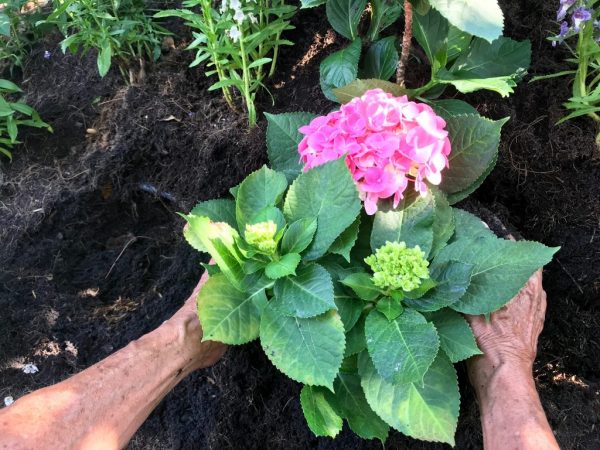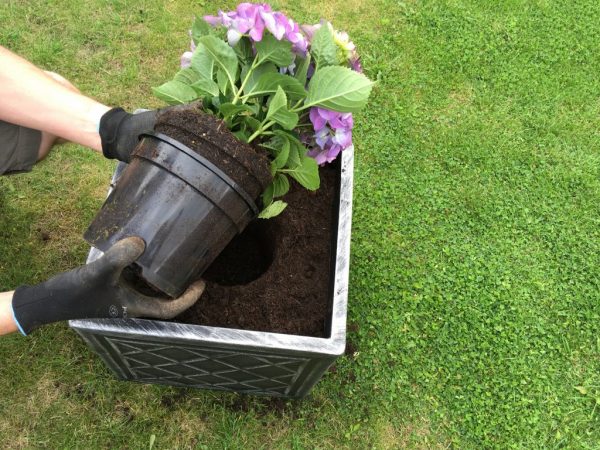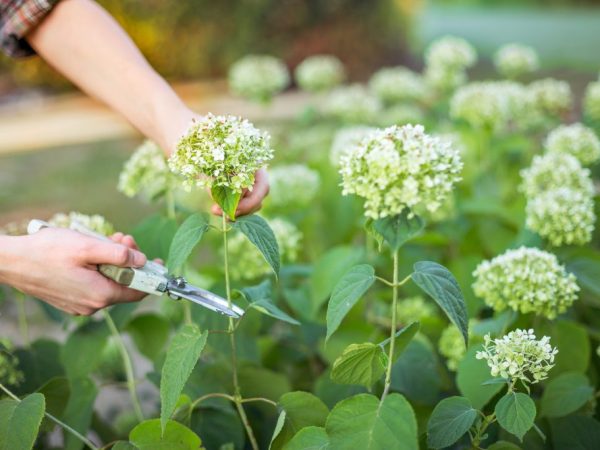Planting hydrangeas outdoors in autumn
In order for the garden to please with beautiful inflorescences at any time, you need to take care of the correct planting of ornamental shrubs. Planting hydrangeas in the fall is not easy moving a flower from a pot to an open ground. There are a number of important factors affecting the development of a plant.

Planting hydrangeas in the fall
general information
Hydrangea is a thermophilic flower that needs moisture and good fertile soil. If these components are respected by the grower, then the autumn planting of hydrangeas will be successful.
There are many different types of this plant, the most popular of which are:
- tree-like;
- freise;
- garden (another name for large-leaved);
- petiolate;
- vanilla;
- paniculate;
- Sargent, etc.
Each of this species, when landing, has some peculiarities. But there are also a number of general rules.
Seat selection
Hydrangea is a light-loving flower, so it can be planted in warm regions, where the sun predominates most of the time.
The seedlings should be protected from strong winds and excessive solar activity. Treelike and panicle hydrangeas are best protected with a little shade during peak heat. If there is diffused light above the plant, then these are ideal conditions for development.
Large-leaved hydrangea, planted in a slightly shaded area, has late flowering with few flowers.
It is better to plant a hydrangea in the fall from the east side so that it receives the required amount of light before noon.
Soil characteristics
the bush grows well on good clay soils with a high humus content. Red earth soils are less suitable, sandy ones are not suitable at all.
Acceptable acidity is 5.5-6 pH, that is, slightly acidic earth. In such areas, in large-leaved hydrangea, the brightest inflorescences can be observed. If the pH is neutral, then the development time of the Shrub increases, and the flowers lose their rich color.
If you plant a hydrangea in an alkaline soil in the fall, this will lead to the development of a disease such as chlorosis. When a plant grows on such soil, there is also a lack of Fe and Mg, so the leaves and flowers turn pale.
When the seedlings are planted, the ground is prepared in advance and the bush is additionally treated with a specialized solution.

Clay soil is best for growing hydrangeas
Preparing the potting soil
An excellent solution in such a situation would be to prepare a balanced soil mixture. It includes:
- Sod, leaf and garden (chernozem) soil;
- Humus;
- Peat;
- Sand;
- Urea (urea);
- Superphosphate (bone meal).
To properly plant hydrangea in the fall, you should adhere to the following proportion: sand earth peat humus 1: 2: 1: 2. Add 1-1.5 tbsp. l. urea, 160-200 g of bone meal or 50-70 g of pure superphosphate.
If there is a pine or spruce forest nearby, you can dig up suitable (loose) soil there. If the seedling is planted in such soil, then there is no need to fertilize.It is strictly forbidden to add ash or lime to the finished substrate.
Disembarkation
The distance when planting shrubs is calculated based on varietal characteristics.
Planting panicle hydrangea in the fall should be at a distance of about 1.6-2.4 m, tree-like 1.4-2 m, garden up to 1-1.4 m.If a florist wants to plant a bush in spring or autumn in one row, making a flower fence , then for such purposes a trench 0.8-1.2 m wide is dug.
To obtain an earlier flowering, holes are dug closer to each other, at a distance of 0.6-0.8 m. After 2 years, if necessary, the shrubs are pruned and thinned out.
The depth of the planting pits is small, 0.3-0.4 m, the width is 0.5-0.65 m. The second parameter is larger, because the root system increases mainly in breadth.
To properly plant a hydrangea in the fall, it is best to follow these instructions:
- 15-25 days before planting is carried out - a hole is dug;
- prepared soil mixture is poured into it;
- then a seedling is taken and placed at a certain depth (the root collar is 2-3 cm lower than the soil level, if this indicator is not observed, the flower will not be able to grow normally);
- the roots are straightened as much as possible and covered with earth from above;
- the shrub is filled with a bucket of water and sprinkled with peat or sawdust on top so that moisture is retained inside the soil. Layer thickness up to 10 cm, circle diameter up to 25 cm;
- the plant must be covered to protect it from gusty winds and excessive solar activity.
The timing of planting hydrangeas in autumn is in September, and in spring - in late April and early May.
If a flower is to be transplanted into open ground, then in the northern (cold) regions it is better to do this in the spring. In the southern (warmer) regions, it is autumn time.
Highlights of care
The first 2-3 years, after the hydrangea was planted in the fall in open ground, the inflorescence is cut off at the moment the first peas (buds) appear. This is necessary for the root system to receive sufficient nutrition for normal growth.

The first 2-3 years, the hydrangea is cut off the inflorescence
Top dressing
Before planting hydrangeas in the fall in open ground, they are not fed. It is better to apply mineral and organic fertilizers at a certain time. Before mid-summer, acidic dressings (Ammonium or potassium sulfate) are added to the soil. From August to mid-autumn, bone meal and superphosphates are added.
During the flowering period, potassium-phosphate dressing is applied. This prolongs the formation of new buds. In order not to harm the shrub, the florist should not:
- Allow excessive nitrogen content. It promotes the development of rot, reduces winter hardiness.
- Use ash. As a substitute, you can use top dressing suitable for rhododendron.
- Allowing an excess of organic matter in the substrate, it contains bacteria that infect the flower.
Watering
The flower loves water, but in the fall it has enough natural precipitation. In summer, the shrub is watered every 14-15 days with 10-20 liters of soft water. Under normal conditions, the frequency of watering is reduced to 1 time in 7 days, the amount of water does not change.
To prevent the appearance of rot, add 2 g of potassium permanganate to the water. Irrigation is done in the near-stem area in the evening or morning. After that, the land around the Bush is necessarily loosened up.
Pruning
When planting hydrangeas in the ground in the fall, the bush will be able to take root and prepare for winter. With the onset of spring, the grower must take care of pruning the shrub. One-year-old hydrangea, which has only recently been planted on the street, cannot be cut off.
By the type of pruning, all known types of hydrangea are divided into groups.
The first
This includes petiolate, garden, serrate, Sargent, prickly and oak-leaved. These species require cosmetic and standard (sanitary) pruning. With the onset of spring or autumn, every 4th branch that is older than three years is pruned.Much attention is paid to weak, broken and growing inward branches. Pruning, besides giving it a unique shape, increases the level of flower formation.
The second
Planting a tree hydrangea in the fall, like a panicle hydrangea, allows you to prune before the eyes open. The most favorable period is the end of March. Formative pruning is done to these plants, if the shrub is oversaturated with flowers, then the inflorescences will be small. Frozen stems are cut to the first living bud.
Shrub rejuvenation
Regardless of when the bush was planted, it is worth rejuvenating it. For this, the stems are cut at a height of 4-6 cm from the ground level.
Even if the planting of garden hydrangeas was carried out in the fall, then they need to be pruned a little so that young shoots can grow in the spring. So the decorative effect of the bush is preserved.
Even in autumn, withered inflorescences are cut off. This is done so that the stems do not break under the snow cover.
Winter care
It is possible to plant hydrangea in autumn both by cuttings and already fully formed bushes. The main thing is to carefully prepare the bush for the cold at this time.
Some varieties have excellent winter hardiness, so mulching is enough to preserve them. In the southern regions, gardeners get by with hilling. But in the conditions of the middle and northern strip, the hydrangea must be covered or dug out for overwintering in the house. The preparations for the measures begin to be carried out in late October and early November.
Young seedlings should be brought into the house, or insulated with something additionally.
Useful Tips
Growing and care:
- If you plan to dry the flowers, then they are cut after blooming. Then they are tied up and left in a dark place.
- It is recommended to plant ground cover plants in the near-trunk circle.
- the shrub is also grown as a pot culture. In winter, they are transferred to a closed room. With the onset of spring time, they are placed in a warm place where there is no direct light hit. In the summer, the flower is taken out into the street. In the fall, you can plant hydrangeas in open ground.
Conclusion
Hydrangea is suitable for both home and backyard growing conditions. In order for the Shrub to develop normally, it needs not only to be planted, but also to organize timely watering, fertilization, pruning and preparation for winter time. Another important point that must be taken into account is the prevention of diseases and pests.

